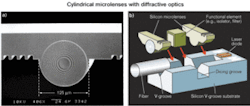Good things in small packages
Starting with the principal of total internal reflection, which guides light through optical fiber, the fundamentals of optics have led to some very successful telecommunications products. Such products are needed now to bring on the full-fledged deployment of optical networking in metro and access markets. And surely the simple, innovative application of optical design principals to components will play a critical enabling role.
High on the list of fundamental optical principals is diffraction. As light travels, it constantly interferes with itself—if it encounters no objects, it moves along without bending. But objects such as apertures or edges modify the interference, causing the light to bend, or diffract. It's a phenomenon first discovered by the Italian Jesuit priest and astronomer Francesco Grimaldi (1618–63) and defined by French civil engineer and physicist Augustin Jean Fresnel (1788–1827). Over the subsequent years, clever design of diffractive optics has led scientists and engineers to control optical wavefronts in many ways, including products such as laser pointers, DVD players, digital cameras, laser welding equipment, and medical diagnostic devices. Diffracting light in optical-networking components is a relatively old story, too, but some recent creative thinking may result in very-low-cost components aimed at the metro and access markets.
By placing a silicon diffractive optical element in a V-groove substrate, engineers at the R&D center of Oki Electric Industry (Tokyo) have created a surface-mounted solution to the vexing question of how to efficiently couple light from a laser diode to singlemode optical fiber. The designers say that is the crucial building block of a universal platform suitable for mass-producible, low-cost, high-performance modules.
The new Oki prototype addresses the cost and optical power losses that come from collimating light through aspherical lenses or other passive alignment components into the fiber. The alignment and packaging requirement are very precise and demanding. Automated surface-mount technology—in which components are placed directly onto a substrate and the fiber laid in a V-shaped groove to align it—has been widely developed to address these issues but has not always met performance demands or market acceptance.
In the Oki design, two 125-µm-diameter cylindrical microlenses with diffractive optics that match up the mode size of the laser diode and the fiber fit into the V-groove to collimate the light (see Figure). A functional element such as a filter or isolator can sit between them; an attached handling section above the cylinder allows automated pick and place operations. The result is a very-low-cost alignment and packaging structure, with coupling efficiency as high as –3 dB between the distributed Bragg diode and the fiber.1, 2The Oki project leader at the advanced devices laboratory, Takeshi Takamori, says that a silicon diffractive element was selected because it allows a short focal length and high diffraction efficiency and can be fabricated at wafer scale by large-scale integration and deep-etching technologies.
On the one hand, integration of diffractive optical elements into laser-diode packages could be simply another minor improvement on the road to component integration and cost reduction. But Takamori's point is really that silicon diffractive optics and surface-mount technology open up a platform for numerous applications, including an optical circuit in fiber to the home optical-networking units, which are common in Japan. An optical subassembly developed by Takamori's group contains the laser diode and microlens and measures <1 mm square. It fits easily within a TO-can.
Prototypes of the lenses and optical subassemblies have already been sold to customers. The combination of optical science and engineering design would have impressed those early explorers of diffractive optics, Grimaldi and Fresnel. Perhaps a few more innovations like that, and we'll find high-speed bandwidth wherever we seek it.
- D. Shimura et al., 2003 Electronic Components and Technology Conference proceedings, New Orleans (May 2003), pp. 1318-22.
- M. Uekawa et al., IEEE Photonics Technology Letters, vol. 15, no. 7 (July 2003), pp. 945-47.
Conard Holton is chief editor or WDM Solutions and executive editor of Laser Focus World. He can be reached at 603-891-9161 or [email protected].

